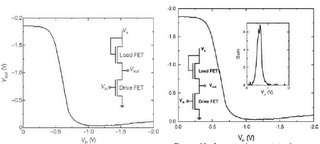When do these coincidences happen?
How is it possible for the same data curves to appear in two different papers about two different species, as it happened in the 1997 studies and in the 1999-2000 studies?
One possibility is that there is a mistake. Someone is not too careful with their figures, they mix them up when they submit them to the journals.
Another possibility is scientific fraud. In fact, fraud is often discovered because of these simple incongruences. For example, consider the famous case of Jan Hendrik Schoen, the Physicist at Bell Labs who had a knack for reusing the same graph in two or three papers, and for extrapolating "measurements" well beyond the region where they were constrained by data.
Below is a famous pair of images from Schoen's opus. The left one appeared in Nature, the right one appeared in Science. The curves are supposed to report on different results, and yet they are identical down to the noise fluctuations.
 The discovery of fraud in Schoen's work led to the withdrawal of a number of papers, including 8 published in Science and 7 published in Nature.
The discovery of fraud in Schoen's work led to the withdrawal of a number of papers, including 8 published in Science and 7 published in Nature.Does this explanation apply to the studies discussed earlier in this blog? Who is in charge of establishing whether there is fraud or not? This will be the topic of a future post.

1 Comments:
This remark as well as the others on your blog have a home at PubPeer.com. If you would like to open the discussion up to a wider audience of colleagues (and the authors) consider reposting some of your observations at pubpeer.com.
Check out some recent comments at pubpeer.com/recent
Post a Comment
<< Home